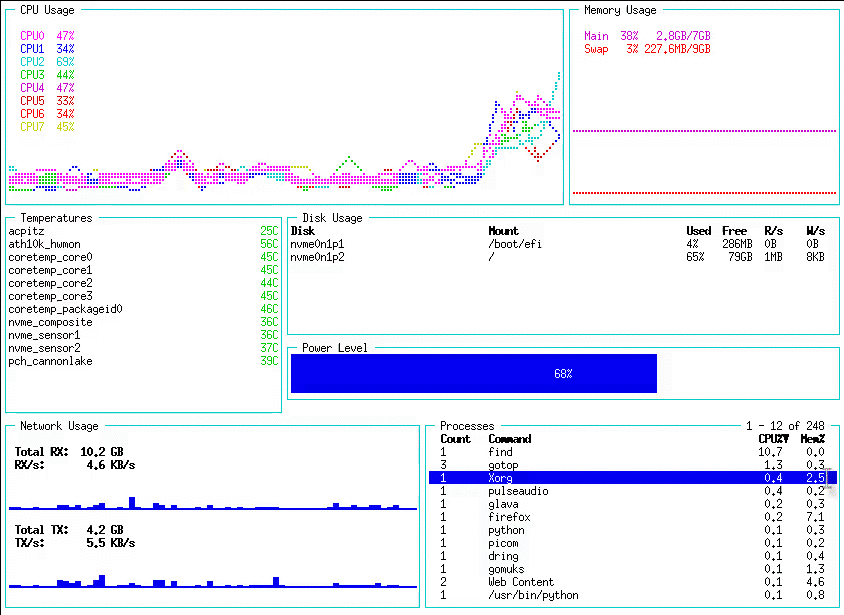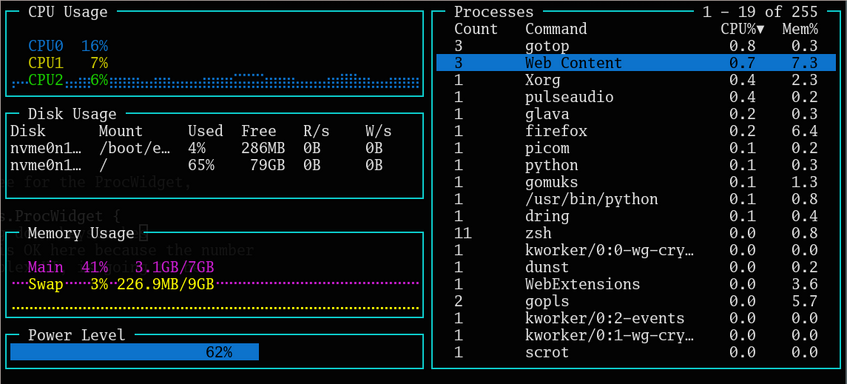8.7 KiB

Another terminal based graphical activity monitor, inspired by gtop and vtop, this time written in Go!
The original author of gotop has re-implemented the application in Rust, as ytop. This is a fork of original gotop project with a new maintainer.


Installation
Working and tested on Linux, FreeBSD and MacOS. Windows binaries are provided, but have limited testing. OpenBSD works with some caveats; cross-compiling is difficult and binaries are not provided.
Arch
AUR contains entries for gotop and gotop-bin. gotop-git still points at the old, unmaintained, repository for the moment.
yay -S gotop-bin
OSX
gotop can be installed with Homebrew; you'll need to tap the recipe. If you'd previously tapped cjbassi's recipe, you'll want to untap that first.
brew untap cjbassi/gotop # If previously tapped
brew tap xxxserxxx/gotop
brew install gotop
Prebuilt binaries
This doesn't require Go, is easy, and works across distributions. You have to manually upgrade the executable yourself, though.
Visit the releases page with your web browser and download the appropriate file for your OS. Unzip it (the archive contains a single file) and then move the resulting gotop binary into your $PATH somewhere. If you're on a Debian or Redhat derivative, you can download an .rpm or .deb and install that.
Source
This requires Go, and at the moment, Go 1.14 specifically.
go get -u github.com/xxxserxxx/gotop/cmd/gotop
Building
This is the download & compile approach.
git clone https://github.com/xxxserxxx/gotop.git
cd gotop
go build -o gotop ./cmd/gotop
Move gotop to somewhere in your $PATH.
To create the cross-compile builds, there's a make.sh script; it has a lot of dependencies and has only been tested on my computer. When it works, it creates archives for numerous OSes & architectures. There's no testing for whether dependencies are available; it assumes they are and will fail in strange ways when they aren't.
- bash
- Go
- zip
- nfpm (for deb & rpm)
- docker (for darwin)
It is just smart enough to not rebuild things when it doesn't have to, and it tries to keep the darwin docker container around so it's not building from scratch every time. There are no guarantees.
Note
make.sh will probably go away soon as the project has shifted to using the github workflow engine to do builds.
Usage
Keybinds
- Quit:
qor<C-c> - Process navigation:
kand<Up>: upjand<Down>: down<C-u>: half page up<C-d>: half page down<C-b>: full page up<C-f>: full page downggand<Home>: jump to topGand<End>: jump to bottom
- Process actions:
<Tab>: toggle process groupingdd: kill selected process or group of processes with SIGTERMd3: kill selected process or group of processes with SIGQUITd9: kill selected process or group of processes with SIGKILL
- Process sorting
c: CPUm: Memp: PID
- Process filtering:
/: start editing filter- (while editing):
<Enter>accept filter<C-c>and<Escape>: clear filter
- CPU and Mem graph scaling:
h: scale inl: scale out
?: toggles keybind help menu
Mouse
- click to select process
- mouse wheel to scroll through processes
Colorschemes
gotop ships with a few colorschemes which can be set with the -c flag followed by the name of one. You can find all the colorschemes in the colorschemes folder.
To make a custom colorscheme, check out the template for instructions and then use default.json as a starter. Then put the file at ~/.config/gotop/<name>.json and load it with gotop -c <name>. Colorschemes PR's are welcome!
Layouts
gotop can parse and render layouts from a specification file. The format is
intentionally simple. The amount of nesting levels is limited. Some examples
are in the layouts directory; you can try each of these with, e.g.,
gotop --layout-file layouts/procs. If you stick your layouts in
$XDG_CONFIG_HOME/gotop, you can reference them on the command line with the
-l argument, e.g. gotop -l procs.
The syntax for each widget in a row is:
(rowspan:)?widget(/weight)?
and these are separated by spaces.
- Each line is a row
- Empty lines are skipped
- Spaces are compressed (so you can do limited visual formatting)
- Legal widget names are: cpu, disk, mem, temp, batt, net, procs
- Widget names are not case sensitive
- The simplest row is a single widget, by name, e.g.
cpu - Weights
- Widgets with no weights have a weight of 1.
- If multiple widgets are put on a row with no weights, they will all have
the same width. - Weights are integers
- A widget will have a width proportional to its weight divided by the
total weight count of the row. E.g.,
The first row will have two widgets: the CPU and network widgets; eachcpu net disk/2 mem/4
will be 50% of the total width wide. The second row will have two
widgets: disk and memory; the first will be 2/6 ~= 33% wide, and the
second will be 5/7 ~= 67% wide (or, memory will be twice as wide as disk).
- If prefixed by a number and colon, the widget will span that number of
rows downward. E.g.
Here, memory and network will be in the same row as CPU, one over the other,mem 2:cpu net
and each half as high as CPU; it'll look like this:+------+------+ | Mem | | +------+ CPU | | Net | | +------+------+ - Negative, 0, or non-integer weights will be recorded as "1". Same for row
spans. - Unrecognized widget names will cause the application to abort.
- In rows with multi-row spanning widgets and weights, weights in
lower rows are ignored. Put the weight on the widgets in that row, not
in later (spanned) rows. - Widgets are filled in top down, left-to-right order.
- The larges row span in a row defines the top-level row span; all smaller
row spans constitude sub-rows in the row. For example,cpu mem/3 net/5
means that net/5 will be 5 rows tall overall, and mem will compose 3 of
them. If following rows do not have enough widgets to fill the gaps,
spacers will be used.
Yes, you're clever enough to break the layout algorithm, but if you try to
build massive edifices, you're in for disappointment.
CLI Options
-c, --color=NAME Set a colorscheme.
-m, --minimal Only show CPU, Mem and Process widgets. (DEPRECATED, use -l minimal)
-r, --rate=RATE Number of times per second to update CPU and Mem widgets [default: 1].
-V, --version Print version and exit.
-p, --percpu Show each CPU in the CPU widget.
-a, --averagecpu Show average CPU in the CPU widget.
-f, --fahrenheit Show temperatures in fahrenheit.
-s, --statusbar Show a statusbar with the time.
-b, --battery Show battery level widget (minimal turns off). (DEPRECATED, use -l battery)
-i, --interface=NAME Select network interface [default: all].
-l, --layout=NAME Choose a layout. gotop searches for a file by NAME in $XDG_CONFIG_HOME/gotop, then relative to the current path. "-" reads a layout from stdin, allowing for simple, one-off layouts such as echo net | gotop -l -
Several interfaces can be defined using comma separated values.
Interfaces can also be ignored using !
More screen shots
"-l battery"

"-l minimal"

Custom (layouts/procs)
